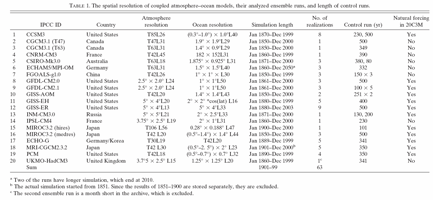
U.S. Dept. of Commerce / NOAA / OAR / PMEL / Publications
Several scenarios are provided by modeling groups for their simulation experiments of late-nineteenth–twentieth- and twenty-first–twenty-third-century projection for IPCC AR4. These state-of-the-art model outputs are archived by the Program for Climate Model Diagnosis and Intercomparison (PCMDI) at Lawrence Livermore National Laboratory (LLNL). In this study we analyze the 20C3M simulation, which includes 63 realizations produced by 20 models. The 20C3M ensemble runs are initialized from their corresponding control runs (PIcntrl), which have neither natural nor anthropogenic external forcing (solar, volcanic aerosol), and then continued with prescribed anthropogenic and, in many cases, natural external forcings based on observations for the twentieth century. Global energy-related and industrial CO2 emissions were relatively low in the first half of the twentieth century; pronounced increases occur after the 1950s (Nakicenovic and Swart 2000, their Fig. 1–3). The resultant CO2 concentration was below 310 ppm before 1950 and then gradually increased to 368 ppm by the year 2000 (Watson et al. 2001). This set of model runs represents the various groups’ best effort to simulate the twentieth-century climate.
Table 1 briefly summarizes the features of the models that were contributed to the 20C3M intercomparison project, including their simulation length, number of realizations, and length of control runs (PIcntrl). By comparison of Table 1 with Table 8.1 from the IPCC Third Assessment Report (TAR: Houghton et al. 2001), both horizontal and vertical resolution of AOGCMs have been improved since TAR. The spectral resolution of the atmosphere GCM was R15 to T47 (only 1) in TAR. Among the 20 models for AR4, 13 are spectral, and the remaining 7 are grid point. The lowest spectral resolution is T42, and the highest resolution is T106, close to 1° in longitude and latitude {Model for Interdisciplinary Research on Climate 3.2, high-resolution version [MIROC3.2(hires)]}. The gridpoint models have about the same spatial resolutions as in TAR. The vertical resolution ranges from 13 levels [Goddard Institute for Space Studies Model E-R (GISS-ER)] to 56 [MIROC3.2(hires)] with 14 models having more than 20 vertical levels. For TAR 27 of 31 models had less than 20 vertical levels.
Table 1.
Studies of temperature change over land areas based on the meteorological station network are routinely made by groups such as the University of East Anglia (UEA), United Kingdom (Jones et al. 1982, 1999), GISS (Hansen and Lebedeff 1987; Hansen et al. 1999), and the National Climatic Data Center (NCDC) (Peterson and Vose 1997; Quayle et al. 1999). Because of different methods for handling data issues, such as incomplete spatial and temporal coverage, urban influences, etc., magnitudes of the derived data fields vary in some degree. The Arctic region is especially sensitive as few stations are available, and the length of the records varies considerably. The variance-adjusted version 5° x 5° land SAT anomalies [Climate Research Unit temperature dataset version 2 (CRUTEM2v)] are widely used; however, a relatively large portion of the high Arctic is data void. Using an “anomaly” approach that attempts to maximize available station data in space and time, the group from the Climate Research Unit (CRU) of UEA constructed a dataset with mean monthly SAT at 0.5° grid horizontal resolution (New et al. 1999, 2000). The anomaly approach first defines the fields of monthly climate anomalies relative to a standard normal period (in this case, 1961–90) mean. The anomaly grids were then combined with this high-resolution mean climatology to arrive at grids ofmonthly climate over the 100-yr period to estimate monthly surface climate. This monthly SAT covers the global land surface (excluding Antarctica) for 1901– 2000 (CRUTS2.0). Our previous comparisons of this dataset with observed records show encouraging results for the Arctic, particularly after 1930 with increased station coverage (Wang and Overland 2004).
Figure 1 shows the comparison of the winter (November–March) averaged land SAT (LSAT) anomaly time series for the Arctic north of 60°N (solid), mid-latitude (45°–60°N) (dashed), and global (dotted) based on CRUTS2.0. We will refer to “winter” as this 5-month average. The positive anomalies in the global mean SAT in recent decades are consequences of the warming in both the Arctic and midlatitude; however, polar amplification is more significant during the mid-century from late 1920s to early 1940s (Johannessen et al. 2004) when a 1901–80 base period is used. For comparison, the winter LSAT anomalies for the Arctic based on CRUTEM2v are also shown (dash–dotted line) in Fig. 1. Both datasets indicate prolonged Arctic-wide warm anomalies of more than 0.7°C at midcentury. They both show a “twin peak” structure in the midcentury warm anomalies, though with a slightly different amplitude. After 1950 there is little difference between the two datasets. The cold period of the 1960s–70s is distinct, and the warm anomalies since the 1980s show an upward trend. In the remainder of this study we focus on the Arctic, and contrast the two periods of warm anomalies as simulated by the AR4 climate models.
FIG. 1. Winter land surface air temperature (LSAT) anomalies averaged over the Arctic (60°–90°N) (thick solid line), midlatitude (45°–60°N) (dashed), and globe (dotted) based on CRUTS2.0 in units of °C. Also shown is the Arctic averages based on CRUTEM2v dataset. The anomalies are relative to a 1901–80 base period. All curves are smoothed with 5-yr running mean.
Return to previous section or go to next section